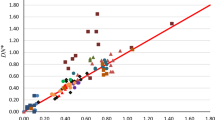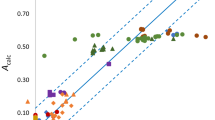Abstract
The electrical properties (dipole moment, polarizability, and first hyperpolarizabilities) of anhydride derivatives are studied using theoretical chemistry methods. Several DFT XC functionals have been used while reliable atomic basis sets have been selected for their evaluations. The variations of (hyper)polarizabilities as a function of the anhydride structure are consistent among the different functionals, which facilitates the deduction of structure–property relationships. It has been observed that (1) The dipole moment of maleic anhydride (2) increases when adding a methyl group (3) and even more when fusing a phenyl ring to get phthalic anhydride (1), in good agreement with experiment. (2) The average polarizability is mostly driven by the molecular size while the polarizability anisotropy presents more subtle variations as a function of the compound. (3) For 1 and 2, the calculated polarizability tensor components are in close agreement with the experimental data. (4) To a good extend, the HRS first hyperpolarizabilities follow the same ordering as the polarizability anisotropy. (5) The EFISHG first hyperpolarizabilities exhibit a completely different ordering while its sign depends on the orientation of the CO double bonds. Finally, since the first hyperpolarizability values of these anhydride derivatives are of moderate amplitude, like those of amino acids, several design strategies have been discussed for achieving their enhancement.







Similar content being viewed by others
References
Iwata S, Tanaka J, Saburo P (1967) Phosphorescence of the charge-transfer triplet states of some molecular complexes. J Chem Phys 47:2203
Koohmareh GA (2012) Synthesis and characterization of new disperse-red functionalized polyimide for use as nonlinear optical material. Des Monomers Polym 15:275–288
George J, Premachandran SK (1978) Growth of phthalic anhydride in a closed crystal-vapour system. J Cryst Growth 43:126
George J, Premachandran SK (1977) Growth and morphology of phthalic anhydride crystals. J Cryst Growth 37:189–193
Arbuzov BA, Novikova LK, Vereshchagin AN (1977) Polarizability anisotropy of maleic and phthalic anhydrides. Russ Chem Bull 26:1996–1997
Safinejad F, Thompson CD, Khiavi MA (2009) Optical and vibrational properties of 1,2-benzenedicarboxylic anhydride. J Mol Model 15:1119–1124
Janarthanan S, Rajan YC, Samuel RS, Pandi S (2012) Crystal growth, spectral, thermal and optical properties of phthalic anhydride (PA) single crystal. Adv Mater Res 584:136–140
Safinejad F, Thompson CD, Khiavi MA (2009) Optical and vibrational properties of 1,2-benzenedicarboxylic anhydride. J Mol Model 15:1119–1124
Frisch MJ et al (2009) Gaussian09, Revision C.01. Gaussian Inc, Wallingford
Becke AD (1988) Density-functional exchange-energy approximation with correct asymptotic behavior. Phys Rev A 8:3098
Becke AD (1993) Density-functional thermochemistry. 3. The role of exact exchange. J Chem Phys 98:5648–5652
Yanai T, Tew DP, Handy NC (2004) A new hybrid exchange-correlation functional using the Coulomb-attenuating method (CAM-B3LYP). Chem Phys Lett 393:51–57
Iikura H, Tsuneda T, Yanai T, Hirao K (2001) A long-range correction scheme for generalized-gradient-approximation exchange functionals. J Chem Phys 115:3540
Zhao Y, Truhlar DG (2008) The M06 suite of density functionals for main group thermochemistry, thermochemical kinetics, noncovalent interactions, excited states, and transition elements: two new functionals and systematic testing. Theor Chem Acc 120:215
Zhao Y, Truhlar DG (2006) Density functional for spectroscopy: no long-range self-interaction error, good performance for Rydberg and charge-transfer states, and better performance on average than B3LYP for ground states. J Phys Chem A 110:13126–13130
Chai DJ, Head-Gordon M (2008) Systematic optimization of long-range corrected hybrid density functionals. J Chem Phys 128:084106
Zhao Y, Schultz NE, Truhlar DG (2006) Design of density functionals by combining the method of constraint satisfaction with parametrization for thermochemistry, thermochemical kinetics, and noncovalent interactions. J Chem Theory Comput 2:364–382
Sekino H, Maeda Y, Kamiya M, Hirao K (2007) Polarizability and second hyperpolarizability evaluation of long molecules by the density functional theory with long-range correction. J Chem Phys 126:014107
Jacquemin D, Perpète EA, Scalmani G, Frisch MJ, Kobayashi R, Adamo C (2007) Assessment of the efficiency of long-range corrected functionals for some properties of large compounds. J Chem Phys 126:144105
Kirtman B, Bonness S, Solis AR, Champagne B, Matsumoto H, Sekino H (2008) Calculation of electric dipole (hyper)polarizabilities by long-range-correction scheme in density functional theory: a systematic assessment for polydiacetylene and polybutatriene oligomers. J Chem Phys 128:114108
Song JW, Watson MA, Sekino H, Hirao K (2008) Nonlinear optical property calculations of polyynes with long-range corrected hybrid exchange-correlation functionals. J Chem Phys 129:024117
Alparone A (2011) Comparative study of CCSD(T) and DFT methods: electronic (hyper)polarizabilities of glycine. Chem Phys Lett 514:21–25
Karamanis P, Marchal R, Carbonniére P, Pouchan P (2011) Doping-enhanced hyperpolarizabilities of silicon clusters: a global ab initio and density functional theory study of Si10 (Li, Na, K)n (n = 1,2) clusters. J Chem Phys 135:044511
Castet F, Champagne B (2012) Assessment of DFT exchange–correlation functionals for evaluating the multipolar contributions to the quadratic nonlinear optical responses of small reference molecules. J Chem Theory Comput 8:2044–2052
Sun H, Autschbach J (2013) Influence of the delocalization error and applicability of optimal functional tuning in density functional calculations of nonlinear optical properties of organic donor–acceptor chromophores. ChemPhysChem 14:2450–2461
Seidler T, Stadnicka K, Champagne B (2014) Evaluation of the linear and second-order NLO properties of molecular crystals within the local field theory: electron correlation effects, choice of XC functional, ZPVA contributions, and impact of the geometry in the case of 2-methyl-4-nitroaniline. J Chem Theory Comput 10:2114–2124
Garrett K, Sosa Vasquez XA, Egri SB, Wilmer J, Johnson LE, Robinson BH, Isborn CM (2014) Optimum exchange for calculation of excitation energies and hyperpolarizabilities of organic electro-optic chromophores. J Chem Theory Comput 10:3821–3831
Hadji D, Rahmouni A (2016) Molecular structure, linear and nonlinear optical properties of some cyclic phosphazenes: a theoretical investigation. J Mol Struct 1106:343–351
Bersohn R, Pao YH, Frisch HL (1966) Double quantum light scattering by molecules. J Chem Phys 45:3184
Adamo C, Jacquemin D (2013) The calculations of excited-state properties with time-dependent density functional theory. Chem Soc Rev 42:845–856
Zutterman F, Louant O, Mercier G, Leyssens T, Champagne B (2018) Predicting keto–enol equilibrium from combining UV/visible absorption spectroscopy with quantum chemical calculations of vibronic structures for many excited states. a case study on salicylideneanilines. J Phys Chem A 122:5370–5374
Pejlovas AP, Sun M, Kukolich SG (2014) Microwave measurements of the spectra and molecular structure for phthalic anhydride. J Mol Spectrosc 299:43–47
Bates RB, Cutler RS (1977) Phthalic anhydride. Acta Crystallogr B 33:895–897
Arbuzov BA, Novikova LK, Vereshchagin AN (1977) Polarizability anisotropy of maleic and phthalic anhydrides. Russ Chem Bull 26:1996–1997
Le Fevre RJW (1965) Molecular refractivity and polarizability. Adv Phys Org Chem 3:1–90
Bishop DM (1994) Explicit nondivergent formulas for atomic and molecular dynamic hyperpolarizabilities. J Chem Phys 100:6535–6542
Champagne B, Kirtman B (2006) Evaluation of alternative sum-over-states expressions for the first hyperpolarizability of push-pull π-conjugated systems. J Chem Phys 125:024101
Pielak K, Bondu F, Sanguinet L, Rodriguez V, Castet F, Champagne B (2019) Acido-triggered switching of the second-order nonlinear optical properties of a ferrocenyl-containing indolino-oxazolidine derivative. Dyes Pigments 160:641–646
de Wergifosse M, de Ruyck J, Champagne B (2014) How the second-order nonlinear optical response of the collagen triple helix appears: a theoretical investigation. J Phys Chem C 118:8595–8602
Kamada K, Ueda M, Nagao H, Tawa K, Sugino T, Shmizu Y, Ohta K (2000) Molecular design for organic nonlinear optics: polarizability and hyperpolarizabilities of furan homologues investigated by ab initio molecular orbital method. J Phys Chem A 104:4723–4734
Bigotto A, Galasso V, Pellizer G, Distefano G, Pappalardo GC, Bergman J, Engman L (1982) Spectroscopic study of phthalic anhydride and its thia, selena, and tellura analogues. Spectrochim Acta 38A:185–192
Prezhdo VV, Kowalski P, Kowalska T, Zubkhova VV, Olan K, Prezhdo OV (2011) Molecular polarizability anisotropy of some five-membered cyclic imides. J Molec Struct 997:20–29
Acknowledgements
D.H. thanks Professor A. Rahmouni for his training on quantum chemistry methods.
Author information
Authors and Affiliations
Corresponding author
Electronic supplementary material
Below is the link to the electronic supplementary material.
Rights and permissions
About this article
Cite this article
Hadji, D., Champagne, B. First Principles Investigation of the Polarizability and First Hyperpolarizability of Anhydride Derivatives. Chemistry Africa 2, 443–453 (2019). https://doi.org/10.1007/s42250-019-00060-3
Received:
Accepted:
Published:
Issue Date:
DOI: https://doi.org/10.1007/s42250-019-00060-3




